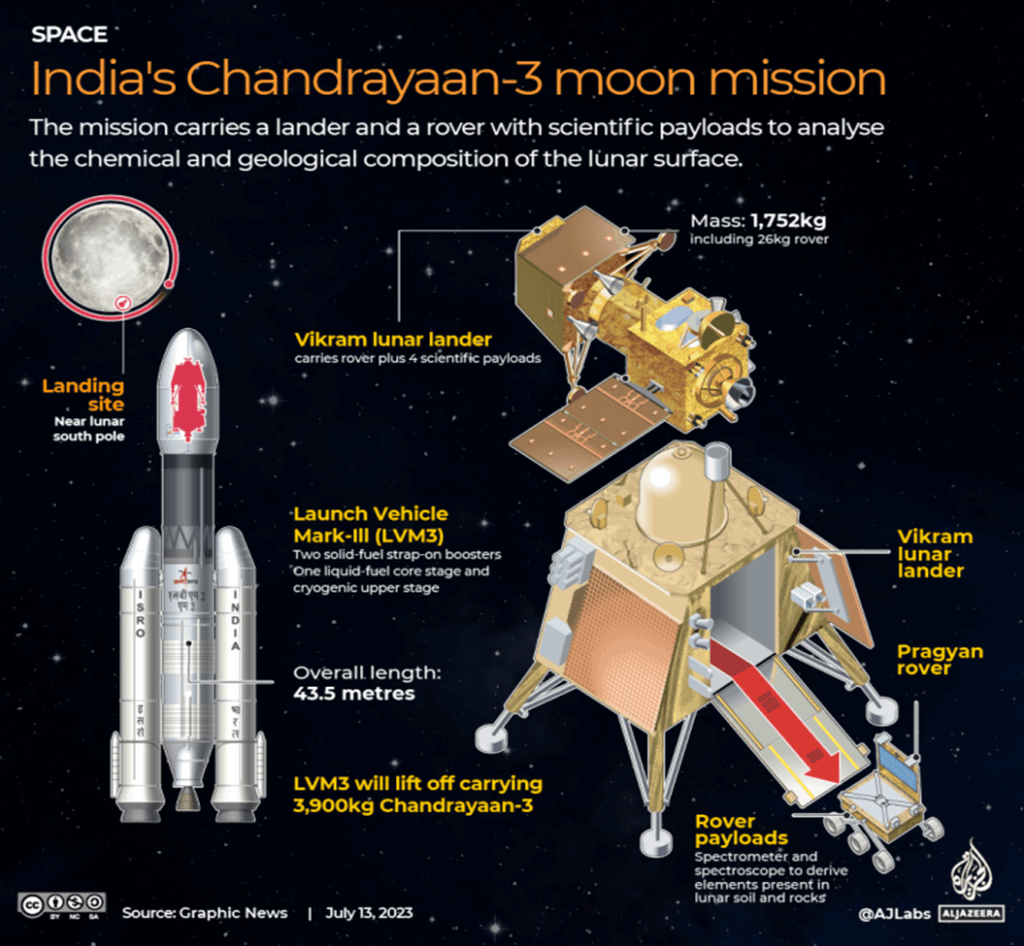Daily Current Affairs : 24-August-2023
India’s Chandrayaan-3 mission has made a historic landing on the lunar surface, marking a significant milestone in space exploration. The mission aims to unlock the mysteries of the Moon’s south pole, a region shrouded in perpetual darkness and believed to hold valuable secrets, including water deposits. This essay delves into the mission’s experiments, the discoveries from previous lunar explorations that inform this mission, and the potential implications for future lunar missions.
Mission Experiments
The Chandrayaan-3 mission is equipped with a suite of cutting-edge experiments to study the Moon’s composition, atmosphere, and seismic activity:
- The Rambha
- Examining the Moon’s ionosphere and atmosphere.
- Monitoring changes in electron and ion densities near the lunar surface over time.
- The ChaSTE
- Investigating the thermal properties of the lunar surface near the polar region.
- Understanding temperature variations in this unique lunar environment.
- The ILSA
- Measuring lunar quakes near the landing site.
- Studying the composition of the Moon’s crust and mantle.
- The LASER Retroreflector Array
- A passive experiment by NASA, serving as a precise target for laser measurements.
- Facilitating accurate data collection for future lunar missions.
- The LIBS
- Identifying the chemical and mineral composition of the lunar surface.
- Offering insights into the Moon’s geological history.
- The APXS
- Determining the presence and concentration of elements in lunar soil and rocks.
- Analyzing elements like magnesium, aluminum, silicon, and more.
Previous Lunar Explorations
Several key discoveries from previous lunar missions lay the groundwork for Chandrayaan-3’s objectives:
- Discovery of Water
- Chandrayaan-1 instruments identified water and hydroxyl molecules in the Moon’s atmosphere and on its surface.
- Mini-SAR and Moon Mineralogy Mapper detected subsurface water-ice in the south pole craters.
- Chandrayaan-2 further mapped lunar water features, distinguishing between water and hydroxyl molecules.
- Buried Lava Tubes
- Terrain mapping and hyperspectral imaging on Chandrayaan-1 uncovered underground lava tubes that could provide safe habitats for future lunar exploration.
- Magma Ocean Hypothesis
- Chandrayaan-1’s M3 payload discovered lighter-density crystals, supporting the theory that the Moon’s surface was once molten.
- A Dynamic Moon
- Chandrayaan-1 revealed evidence of recent volcanic activity, contradicting the belief in lunar dormancy.
- Carbon dioxide measurements suggested ongoing lunar exosphere interactions.
- Solar Flares
- Chandrayaan-2 observed solar microflares, providing insights into the Sun’s atmospheric heating.
- Mapping of Minerals
- The CLASS X-ray Fluorescence experiment extensively mapped lunar minerals.
- Abundant oxygen in lunar minerals holds potential as fuel for future missions.

Important Points:
Mission Experiments
- The Rambha: Studies Moon’s ionosphere and atmosphere, tracks changes in electron and ion densities.
- The ChaSTE: Investigates thermal properties of the lunar surface near the polar region.
- The ILSA: Measures lunar quakes and analyzes Moon’s crust and mantle composition.
- The LASER Retroreflector Array: Passive NASA experiment for precise laser measurements.
- The LIBS: Identifies lunar surface’s chemical and mineral composition.
- The APXS: Determines elements in lunar soil and rocks like magnesium, aluminum, silicon.
Previous Lunar Explorations
- Discovery of Water: Detection of water and hydroxyl molecules in Moon’s atmosphere and on its surface.
- Buried Lava Tubes: Identification of underground lava tubes for potential habitats.
- Magma Ocean Hypothesis: Support for the theory that the Moon’s surface was once molten.
- A Dynamic Moon: Evidence of recent volcanic activity and lunar exosphere interactions.
- Solar Flares: Observation of solar microflares for insights into the Sun’s atmospheric heating.
- Mapping of Minerals: Extensive mapping of lunar minerals, revealing abundant oxygen for potential fuel.
Why In News
Following the triumphant touchdown of the Chandrayaan-3 lander, the six-wheel, 26-kg rover, boasting the remarkable ability to traverse up to 500 meters at a leisurely pace, will embark on its mission of comprehensive lunar exploration. Equipped with cutting-edge instruments and driven by the spirit of scientific discovery, it will unravel the mysteries of the lunar landscape like never before.
MCQs about Unlocking Lunar Secrets with Chandrayaan-3
-
What is the primary objective of the Chandrayaan-3 mission?
A. Studying Martian atmosphere
B. Investigating the lunar surface’s thermal properties
C. Analyzing the composition of Venus’s crust
D. Monitoring the Earth’s ionosphere
-
What did previous lunar explorations reveal about the Moon’s surface composition?
A. Evidence of recent volcanic activity
B. Abundant oxygen in lunar minerals
C. Presence of water and hydroxyl molecules
D. Detection of solar microflares
-
Which experiment on Chandrayaan-3 serves as a precise target for laser measurements?
A. The Rambha
B. The ILSA
C. The LASER Retroreflector Array
D. The APXS
-
What significant discovery was made by instruments on board Chandrayaan-1 regarding the Moon’s atmosphere?
A. Detection of Martian water ice
B. Identification of lunar quakes
C. Presence of water and hydroxyl molecules
D. Evidence of underground lava tubes
Boost up your confidence by appearing our Weekly Current Affairs Multiple Choice Questions
![]()


